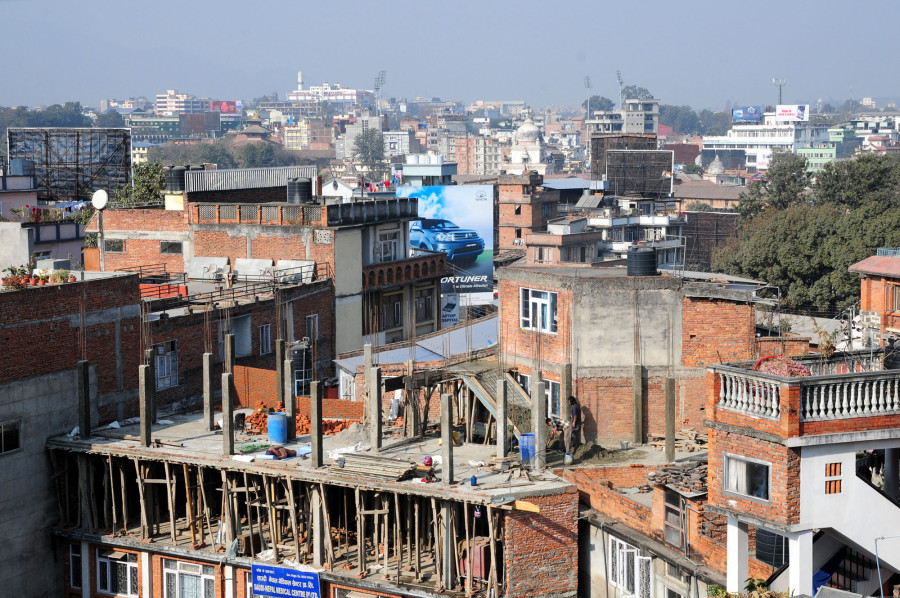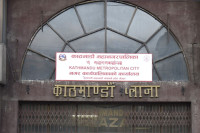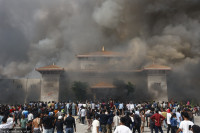Valley
Kathmandu metropolis and federal government agency spar over building codes
Amid a raging dispute between the Kathmandu Metropolitan City and the Kathmandu Valley Development Authority over the building standards, the metropolis has claimed that 80 percent of the houses in Kathmandu may have to be brought down if it were to follow the building regulations set by the federal government.
Prithvi Man Shrestha
Amid a raging dispute between the Kathmandu Metropolitan City and the Kathmandu Valley Development Authority over the building standards, the metropolis has claimed that 80 percent of the houses in Kathmandu may have to be brought down if it were to follow the building regulations set by the federal government.
The Kathmandu Valley Development Authority, which is responsible for enforcement of the building standards enforced by the federal government, in February approached the Supreme Court challenging the metropolitan city’s move of setting its own standards for building construction in the city.
The authority cites Section 27 (5) of the Local Level Operation Act to claim that the municipalities and rural municipalities can determine the standards for building construction “without going against the existing laws and standards set by the federal government”.
While the metropolis claims that the standards set by it are not much different from what the federal government has issued, it has made some adjustments based on its jurisdiction. The metropolis is of the view that the adjustment is necessary to ensure that most of the houses that were built earlier should remain intact.
“If we implement the standards set by the federal government as they are, 80 percent of the houses in the city should be brought down. This is practically impossible,” said Ishwor Man Dangol, spokesperson for the Kathmandu Metropolitan City.
“This situation arose because many people had constructed buildings/houses over the last three decades going against the building permits issued by the metropolis.”
On July 11, 2018, the metropolis introduced its own standards by publishing a notice in the local gazette. Terming the city’s standards weaker than those set by the federal government, the Authority said it wrote to the metropolis on January 13 and sent a reminder on February 6 to correct the standards.
After the metropolis did not respond, the Authority went to court, saying that the standards set by the metropolis are against those introduced by the Cabinet for municipalities and the erstwhile Village Development Committees in 2007. Then again the Basic Standard on Settlement Development, Urban Planning and Building Construction-2015 was introduced after the deadly earthquake in April 2015. While the first building code in 2007 was prepared by the government for the Kathmandu Valley, the 2015 regulations were meant for the entire country.
The standards introduced after the earthquake told local governments that they cannot introduce standards weaker than those in practice.
In case of the buildings that have already been constructed, local governments are permitted to regularise up to 17-metre tall buildings by confirming that they have followed the 2007 standards.
In case of buildings above 17 metres, local governments have to take approval from the Urban Development Office under the Ministry of Urban Development.
The metropolis has authorised construction of buildings taller than the limit prescribed in the government’s 2007 standards for the municipalities and the erstwhile village development committees, which do not exist now after the 2017 local elections, the authority said.
As per the standards set by the Authority, no building can have more than five storeys in protected sub-zones and mixed old settlements. But the metropolis has permitted even seven-storey buildings in the protected sub-zones and eight-storey buildings in mixed old settlements.
The metropolis has also allowed buildings to occupy more space than that specified for the plot, going against the standards set by the government in 2007, according to the Authority.
The space occupied by a building compared to the total plot area is known as the floor area ratio. The federal government has set the floor area ratio at 2.5, while the metropolis has set the ratio at 3.5 for commercial buildings. The floor area ratio is higher in standards set by the metropolis in most types of buildings—commercial buildings and hotels. The floor area ratio is calculated by dividing the total area of the floors by the area of the plot on which the building is constructed.
According to Dangol, then Kathmandu Valley City Development Committee failed to take action against those who constructed buildings going against the prescribed standards. The Kathmandu Valley Development Authority is a transformed unit of the City Development Committee.
Dangol, however, said that they have given completion certificates only to those buildings which have a strong base to sustain the number of floors. However, officials at the Authority argue that the metropolis cannot exercise powers to implement weaker standards as per Section 27 (5) of the Local Level Operation Act and Basic Construction Standards for Settlement Development, Urban Planning and Building Construction 2015.
This dispute between the two sides also brought the issue of jurisdiction between the federal government agency and the local authority, with the metropolis claiming that, as an elected body, it has every right to introduce its own standards.
Experts on federalism practices say officials and elected representatives must clearly understand the constitutional provisions as well as powers delegated to them to effectively implement federalism.
Khim Lal Devekota, who has studied the federal system of governance, said local administrations should follow the building construction standards set by the federal government. “But there seems to be a lack of understanding among the officials and elected representatives about the jurisdiction,” said Devkota, who is also the vice-chairman of the Policy Commission of Province 3.
“In most of the cases, the federal government has overstepped the jurisdiction of the provincial and local governments,” he said.
The provinces have been protesting the federal government’s decision to appoint chief district officers as its representative and limit powers delegated to the provinces to mobilise police claiming that maintaining law and order is the sole jurisdiction of the provincial governments. The local governments have also been protesting against the federal government’s plans to mobilise teachers up to the secondary level although secondary education comes under the jurisdiction of local governments as per the constitution.
This is the latest example of municipalities in Kathmandu Valley protesting the federal government’s moves.
Bhaikaji Tiwari, the development commissioner at the Authority, defended the authority’s position saying that local governments should also follow the federal laws and rules as per the constitution. “New building code introduced by the metropolis without following the central government’s standards would promote construction of weak buildings,” he said. “After the deadly earthquakes of 2015, it has become apparent that we cannot compromise on standards on building construction,” he said.
Asked about the claim of the metropolis that many houses may have to be demolished, he said the government must be strict on implementation to prevent any future disaster. The Authority has made its position clear in a written reply to the Supreme Court on another writ petition filed against the standards set by the Kathmandu Metropolitan City.
In support of the authority’s position, Kapil Mani Poudel, a lawyer, had filed a writ at the Supreme Court on January 30, demanding an interim order not to implement the building standards set by the metropolis. His argument is also similar to that of the Authority, but it has also made the Authority defendant for failing to act against the Kathmandu city.
“If the Kathmandu Metropolitan City is allowed to implement weak standards, it will give rise to haphazard urbanisation. More unsafe buildings will crop up,” the Authority said in a written reply to the Supreme Court in response to the court case filed by Poudel.
After the court on April 19 issued a show-cause notice in the name of the defendants, the Authority on May 6 furnished its response in writing.
In its reply, the Authority has reiterated that the municipal standards would fuel haphazard urbanisation in Kathmandu.
“If buildings are allowed as per the municipal standards, the city will have less open space,” the Authority has said in its response. “Taller buildings with more floors will mean they will be accommodating more people, which will make it difficult for managing drainage, electricity, water and road facilities.”
After the Authority went all out against the Kathmandu city office, the metropolis brought together 17 other municipalities in the Valley to protest against the Kathmandu Valley Development Authority.
The grouping of the municipalities last week demanded that the Authority be scrapped altogether because it was overstepping the jurisdiction of the local governments.
But former chief secretary Som Lal Subedi, who has expertise on federal affairs, said that local governments should not only seek authority as per the jurisdiction set by the constitution, they should also use their powers responsibly.
“In the case of building standards, the Kathmandu Metropolitan City must follow the guidelines of the federal government as it is also related to disaster management which comes under the concurrent jurisdictions of all three layers of government,” said Subedi. “If it is technically difficult to implement the standards set by the federal government, the metropolis should come up with the technical basis for rejecting the standards set by the federal government.”




 14.12°C Kathmandu
14.12°C Kathmandu











